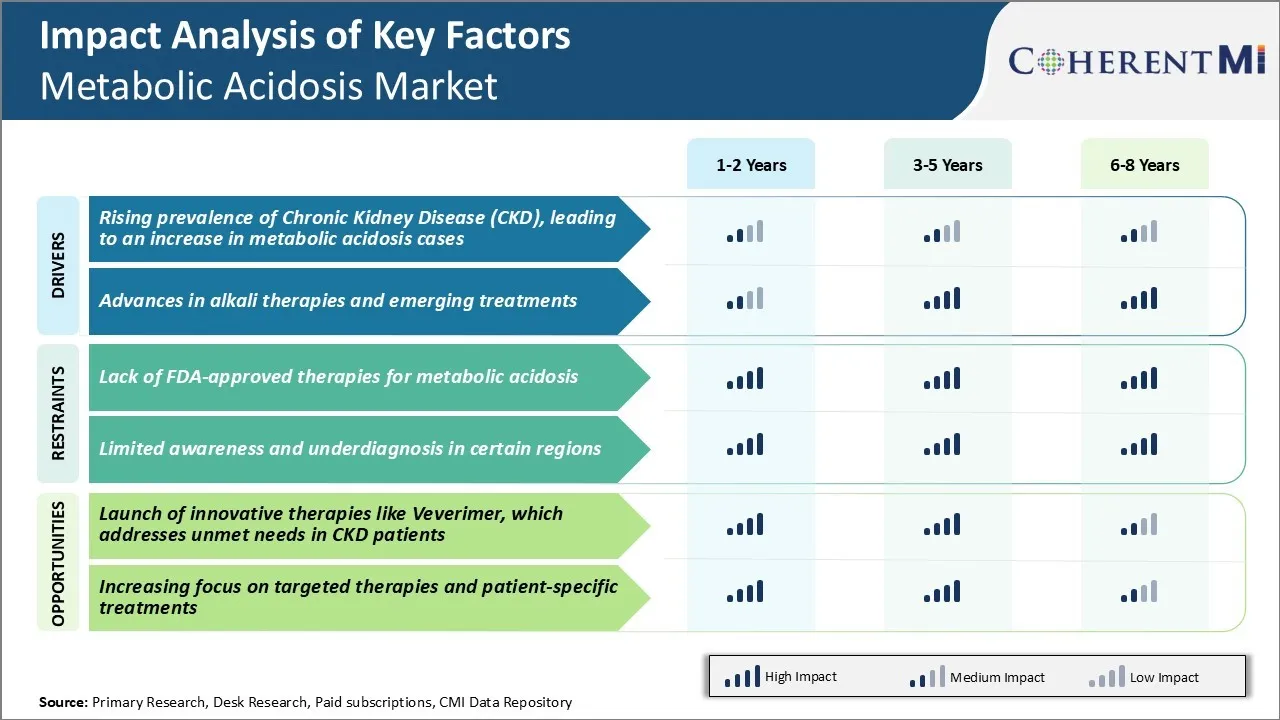代謝性アシドーシス市場 サイズ - 分析
市場規模(米ドル) Mn
CAGR6.1%
| 調査期間 | 2025-2032 |
| 推定の基準年 | 2024 |
| CAGR | 6.1% |
| 市場集中度 | High |
| 主要プレーヤー | Tisentoの治療薬, トリシダ, アドビセンヌファーマ, Zagociguat, オーストラリア, ノベルティ その他 |
お知らせください!
代謝性アシドーシス市場 トレンド
市場ドライバー - Alkaliの療法およびEmergingの処置の進歩
かなりの研究努力は、近年代謝酸症のためのより効果的なアルカリ療法および新規治療アプローチを開発するために向けられました。 重炭酸ナトリウムを含む従来のアルカリ処理を最適化し、耐食性やコンプライアンスなどの課題を克服しました。 Advancesは、処方、配送方法、および拡張リリースプロファイルを改善しました。 ノベルアルカリ塩と酸の結合剤は、緩衝能力を強化し、容積の負担を軽減する製品も登場しました。 これらの新興アルカリオプションは、より柔軟で利便性の高い医師や患者に提供されます。
また、酸の蓄積に対処するための新しいメカニズムは調査中である。 焦点のEmerging区域は内因性の酸の生産を禁止し、循環の酸をトラッピングし、腸の微生物活動を調節します。 これらの代替アプローチをターゲティングするいくつかの候補者は、段階的な開発で数少ない臨床試験に入りました。
研究者は、現在のアルカリ療法単独でより耐久性のあるソリューションを提供する可能性があります。 うまく開発すれば、これらの新しい世代の代謝の酸性症の療法は進むべき大きい市場占有率を捕獲します。 試験および承認による候補者の継続的な進行は、中長期に代謝酸性症市場での強力な成長機会を維持する必要があります。

マーケット・オポチュニティ - Veverimerのような革新的なセラピーの開始
代謝の酸性症の市場での1つの主要な機会は、安全で効果的なFDA承認治療オプションのための現在のアンメットの必要性に対処することができる新規薬の発売です。 Veverimer(Takhzyro)は、最近、慢性腎臓病(CKD)患者における新陳代謝酸症の治療に約束を示した革新的な非吸収性ポリマーです。
承認された場合、Veverimerは特にCKDの慢性の新陳代謝の酸症の処置のために示される最初の薬剤です。 これは、潜在的に酸性症に苦しんでいる観察されたCKDの患者集団のかなりの部分を捕獲する可能性があります。 Veverimerの作用の新型メカニズムおよびシステム吸収なしで酸低下の利益の強い証拠はCKDのための画期的な薬剤としてそれよく置かれます。
その承認は、よりR&D投資と革新的なパイプラインプログラムに市場を推進し、重要な治療目標として酸性症を検証することができます。 全体的に、Veverimerのような一流の療法は処置の選択を革命化し、忍耐強い取入口を運転し、新陳代謝の酸性症の市場の景色を変形させる潜在性があります。
処方者の好み 代謝性アシドーシス市場
代謝酸症を治療するための処方者は、条件の根本的な原因と重症度に依存する可能性があります。 原因が知られていると一時的である軽度の症例では、処方者は、酸基の不均衡を修正するための第一線療法として経口ビカーンサプリメントを好むかもしれません。
より深刻なまたは生命を脅かす場合、または原因が不明または慢性的である場合、処方者は、より急速にpHおよび電解質レベルを正常化するために、IVバイカーボネートまたは他の緩衝剤を検討する可能性が高い。 選択は患者の臨床安定性、comorbidities、および別の管理された物質またはルートのための許容の要因かもしれません。
根本的な貢献の問題の追加管理も、腎臓疾患の代替療法などの処方に影響を及ぼすであろう。 より良い全体的な健康の若い患者は、複数の慢性疾患を持つ高齢者よりもより柔軟な選択肢を持つ可能性があります。
コスト、保険のカバレッジ、処方包含、薬の全体的な安全プロファイルは、同じ指標で利用可能な他の人と比較して、ブランドや一般的な好みに影響を与える可能性があります。 ピアレビューされた証拠、臨床経験、広告または昇進は知覚を形作るかもしれません。
治療オプション分析 代謝性アシドーシス市場
メタボリック酸症は、条件の根本的な原因と重症度に応じて、いくつかの潜在的な治療オプションを持っています。 マイルドケースは、下痢を解決したり、水分摂取量を増加したり、補う重炭酸塩を使用して、根本的な原因に対処することによって処理することができます。
重度の症例では、静脈内ナトリウムビカーボネート療法は、血液pHレベルを上げるための標準的な第一線治療です。 いくつかの薬は、血液の緩衝能力を増加するナトリウムビカルト(Bicitra)を含む一般的に使用されています。 急性の腎臓の傷害の場合のために、bicarbonate療法は患者の根本的な状態を改善し、腎臓機能のさらなる悪化を防ぐことを目指しています。
バイカーボネート療法単独で十分な正しい酸性症がない場合、有害な治療が必要な場合があります。 耐火乳酸症のシナリオでは、緩衝の代理店は通常細胞の新陳代謝を支えるためにチアミンと結合されます。 furosemide (Lasix)のような利尿症を誘発する薬剤はまた十分な水和および電解物のレベルを維持している間、余分な酸を取り除きます。
長期管理を必要とする慢性腎臓病患者のために、経口ナトリウムビカルト(Bicitra)は、頻繁な病院の訪問から合併症を防ぐため、静脈内経路で好まれています。 電解液および酸基の状態の近い監視はまだチェックされていない場合、処理されていない新陳代謝の酸性症が時間の経過とともに腎臓の損傷を加速できるので必要です。
主要プレーヤーが採用した主な勝利戦略 代謝性アシドーシス市場
製品イノベーション: 新製品開発とイノベーションは、企業がエッジを獲得するための大きな戦略でした。 例えば、2020年AstraZenecaでは、成人の新陳代謝の高血症(高カリウムレベル)の治療のためのLokelma (ナトリウムのジルコニウムのcyclosilicate)のためのFDAの承認を受けました。
戦略的買収: 補完技術や企業が製品ポートフォリオを拡大するのを支援しました。 2017年、Freseniusの医学の心配は2億ドルの透析装置およびサービスの一流の提供者NxStageの医学を得ました。 これは、慢性腎臓病および腎代替療法のためのフレセニウスのソリューションの範囲を拡大し、代謝酸症の治療に使用されます。 ほぼ50%の家庭の透析で市場シェアを高めました。
流通ネットワークを拡大: : : より広い地理的な範囲は新しい忍耐強いプールにアクセスできます。 2015年に、Aetnaは、北東米のプロバイダのネットワークを拡大し、会員がメタボリックの専門家にアクセスし、関連する試験/治療のための広範なカバレッジを増やしました。
精密マーケティング: 最新の治療ガイドラインやオプションに関する医師や患者を教育するターゲットキャンペーンは、配当金を支払っています。 DaVitaは、メタボリック酸症の症状と統合ケアサービスに関するデジタルおよびオンラインマーケティングに焦点を合わせ、2018-2020年のほぼ25%で成長し、容量の活用を改善しました。
セグメント分析 代謝性アシドーシス市場

洞察力、治療による:効果的な治療法に対する意識と需要の増加は、バイカーボネート療法のセグメントをブースト
治療の面では、バイカーボネート療法は2024年に市場の47.6%のシェアを保持するように計画され、酸ベースのバランスを回復し、ヘルスケアプロバイダーと患者間の意識を高める。 経口だけでなく、静脈内バイカーボネートサプリメントは、過剰な酸性およびアメリオレート酸症の症状を効率的に中和するのに役立ちます。 重度の新陳代謝の酸症の条件の場合にはそれらの利用は広く文書化されます。
また、代替薬理療法の限られた可用性は、特に貴重なビカルト療法になります。 急な救済のための健康意識と需要を成長させ、さらに重炭酸サプリメントのより大きな採用と臨床設定のソリューションを促進します。
追加の洞察 代謝性アシドーシス市場
- 2023年、約1.7百万の代謝酸症例が7つの主要な市場(7MM)を渡って診断されました。 米国の約850,000の症例は、慢性腎臓病(CKD)の段階3〜5にリンクされていました。
- 性別固有の優先順位: 2023年に、男性はより高いCKDおよび糖尿病の prevalence による診断された新陳代謝症の場合の 55% のために考慮しました。
- 米国市場は、先進医療インフラにより70%の市場シェアを占めています。 2023年、米国における新陳代謝薬の市場規模は117.6百万米ドルでした。 ドイツはEUで最大の市場であり、USD 9.1百万の価値を持ちます。
競合の概要 代謝性アシドーシス市場
代謝薬市場で動作する主要なプレーヤーは、チゼント治療薬、Tricida、Advicenne Pharma、Zagociguat、Freseniusの医療、Novaartis、Relypsa、Inc.、Zydus Cadila、およびAmnealの医薬品を含みます。
代謝性アシドーシス市場 リーダー
- Tisentoの治療薬
- トリシダ
- アドビセンヌファーマ
- Zagociguat, オーストラリア
- ノベルティ
代謝性アシドーシス市場 - 競合関係

代謝性アシドーシス市場
(大手プレーヤーが支配)
(多くのプレーヤーが参入し、競争が激しい。)
最近の動向 代謝性アシドーシス市場
- 2024年6月、Tisento Therapeuticsは、新陳代謝酸症を治療するための経口錠剤であるZagociguatが、第II相試験に合格し、酸性症のための治療オプションの重要な進歩を示すことを発表しました。 試験開始日は、2020年9月25日(水)に予定されている完了日を予定しています。 Zagociguat は現在、フェーズ 2b 臨床試験に移行しています。, その有効性と安全性を評価することを目的としています。. この薬は、中枢神経系(CNS)と疲労や認知障害などの周辺症状に作用する溶性のグアニレートサイクラーゼ(sGC)刺激剤として、そのメカニズムに注目できます。
- 2024年3月、Tricidaは欧州の製薬会社とパートナーシップを結び、EU4諸国の代謝酸症治療薬を配布しました。 アクセシビリティと市場浸透を高めることが期待されます。
- 2023年8月、アドビセンヌは、胎児腎結核(dRTA)の治療として、選択市場でADV7103を発売しました。 この処置はボディの酸のバランスに影響を与えるまれな腎臓状態を目標としている患者のための新しい治療上の選択を提供します。 ADV7103は、長期リリース処方でカリウムクエン酸塩とカリウムビカーボネートの組み合わせです。これは、体内の酸性レベルを管理し、大人における子供や腎臓関連の問題の増殖抑制のような合併症を潜在的に軽減するのに役立ちます。 この起動は、このまれな状態に苦しんでいる患者のための重要な救済を提供します, 治療オプションは、前に制限されていました.
- 2023年7月、アビセンヌファーマは、初期段階のCKD関連代謝酸症を目指した新たなビカルト治療の開発を発表しました。 初期の介入療法で重要なギャップを埋めます。 Advicenneの重要な焦点は、英国を含むヨーロッパの肯定的な臨床試験とマーケティングの承認を見てきた、致命的な腎結核(dRTA)を主に目的とする処置であるADV7103(Sibnayal)にありました。
- 2019年より、TricidaはFDAのアクセラレーテッド承認プログラムでVeverimerのNDAを提出し、FDAは2020年のPDUFA日付でレビューのためにそれを受け入れました。 しかし、FDAは、承認を遅らせる2020年8月に完全な応答レター(CRL)を発行し、治療の有効性とその適用性に関する追加データの必要性を引用しました。
代謝性アシドーシス市場 セグメンテーション
- タイプ別
- 急性メタボリック酸症
- 薬物誘発性アシドーシス
- 乳酸症
- 慢性メタボリック酸症
- 腎管状酸症
- 糖尿病性ケトエイシス
- 急性メタボリック酸症
- 治療によって
- バイカーボネート セラピー
- 経口ビカルト
- 静脈ビカルト
- 透析
- 血液透析
- 腹膜透析
- 薬理学 エージェント
- 重炭酸ナトリウムのタブレット
- カリウムのクエン酸塩の補足
- バイカーボネート セラピー
- エンドユーザ
- 病院
- 患者サービス
- 外来サービス
- クリニック
- 専門クリニック
- 一般クリニック
- ホームケア設定
- ホーム 透析
- ホーム 医薬品管理
- 病院

購入オプションを検討しますか?このレポートの個々のセクション?
Vipul Patil は、製薬業界で 6 年間の経験を積んだダイナミックな経営コンサルタントです。分析力と戦略的洞察力に優れた Vipul は、製薬会社と提携して業務効率の向上、より広範な拡大、収益性の高い市場での流通の複雑さへの対応に成功しています。
よくある質問 :
どのように大きな代謝酸症市場ですか?
メタボリック酸症市場は、2024年にUSD 177.9 Mnで評価され、2031までにUSD 265.5 Mnに達すると予想されます。
代謝酸症市場の成長を妨げる重要な要因は何ですか?
代謝酸症および限られた認識のためのFDA承認療法の欠如は、特定の地域の診断は、代謝酸症の市場の成長を妨げる主要な要因である。
代謝酸症の市場成長を促進する主要な要因は何ですか?
慢性腎臓病(CKD)の上昇の優先順位は、新陳代謝酸症症症例の増加につながり、アルカリ療法および新興治療の進歩に繋がる主要な要因は、新陳代謝酸症市場を運転する主要な要因です。
代謝酸症市場でのリーディングタイプは?
主要なタイプ区分は急性新陳代謝の酸性症です。
主要なプレーヤーは、代謝産物市場で動作していますか?
Tisentoの治療薬、Tricida、Advicenne Pharma、Zagociguat、Fredseniusの医療、Novaartis、Relypsa、Inc.、Zydus Cadila、およびAmnealの薬剤は主要なプレーヤーです。
代謝酸性症市場のCATGは何ですか?
2024-2031年の代謝酸症の市場でのCAGRは、5.89%を予測しています。